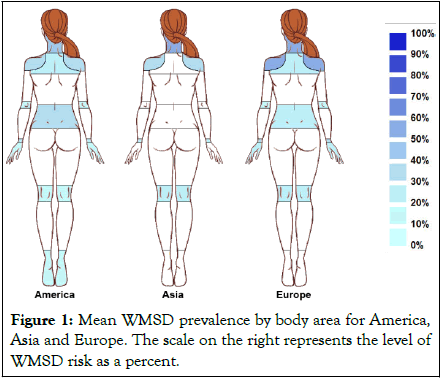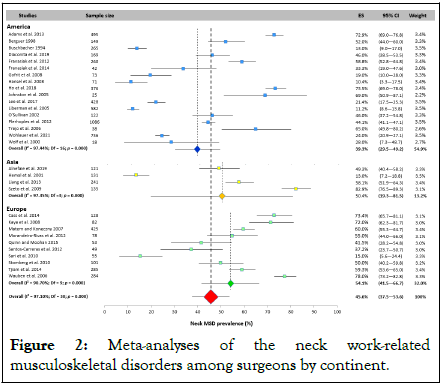International Journal of Physical Medicine & Rehabilitation
Open Access
ISSN: 2329-9096
ISSN: 2329-9096
Brief Report - (2023)Volume 11, Issue 8
Surgeons are highly exposed to Work-Related Musculoskeletal Disorders (WMSDs). The objective of this systematic review and meta-analysis was to summarize the WMSDprevalence by body area with assistive devices among American, Asian, and European surgeons. Thirty-three studies were included in theanalysis. A meta-analysis was performed for five body areas: neck, back, shoulder, wrist, and knee. No sufficient data were available for the other body areas. High heterogeneity (Cochran's Q test and I² statistic) was observed. The worldwide WMSD prevalence was 45.6% for neck, 49.1% for back, 41.6% for shoulder, 28.1% for wrist, and 18.5% for knee. Random effects model revealed the highest prevalence was for neck (America: 39.3%-CI 95%: 29.5-49.2%; Asia: 50.4%-CI95%: 19.3-81.5%; Europe: 54.1%-CI 95%: 41.5-66.7%), back (America: 38.5%-CI 95%: 13.2-63.8%; Asia: 40.7%-CI 95%: 5.0-76.6%; Europe: 58.7%-CI 95%: 40.9-76.6%), shoulder (America: 35.9%-CI 95%: 25.2-46.7%; Asia:35.6%-CI 95%: 21.2-50.1%; Europe: 51.4%-CI 95%: 41.5-61.4%), wrist (America: 27.2%-CI 95%: 19.5-34.9%; Asia: 25.8%-CI 95%: 15.0-36.5%; Europe: 31.8%-CI 95%: 18.1-45.5%), and knee (America: 11.9%-CI 95%: 3.5-20.4%; Asia: 19.6%- CI 95%: 6.5-32.7%; Europe: 26.7%-CI 95%: 20.0-33.3%). Americansurgeons using video orrobotic assistance appear to have a lower risk of WMSDs in these five areas than European surgeons.
Musculoskeletal disorders; Prevalence per continent; Body area
Surgeons need a wide range of skills when performing open surgery. Their interventions require precision and concentration over long periods. Robotic and video-assisted surgeries have revolutionized the field of medicine, providing surgeons with enhanced precision and dexterity during procedures. This leads them to maintain and repeat often awkward static postures, which are responsible for the occurrence of Work-Related Musculoskeletal Disorders (WMSDs). Studies reported that the prevalence is very high, between 80% and 90% [1]. The most exposed areas to WMSDs are the neck, lower back, shoulders and wrists [2].
Technological advances have enabled the introduction of minimally invasive techniques to reduce the consequences of open surgery. Despite the benefits in terms of patient comfort and recovery, the benefits for the surgeon remain sparse. Indeed, Talamini, et al. suggested that the use of robotic assistants during surgery was more ergonomic and less stressful than conventional surgery [3]. Other studies have reported the presence of fatigue during minimally invasive surgery, or consistently high prevalence for the same areas (neck, lower back, shoulder, and wrist [4,5]. So, despite the growing use of robotic assistances in surgery, the question of the presence of WMSDs among surgeons still remains.
To estimate the risk of WMSD among surgeons, it is necessary to conduct meta-analyses. In 2007, Epstein, et al. proposed an analysis for four body zones (neck, shoulder, back and upper extremity) and evaluated the effect of data collection tools [6]. More recently, Gorce, et al. performed a meta-analysis to assess the effect of video and robotic assistance on the WMSD prevalence in ten body zones [7]. The results showed that the use of robotic-assisted and video-assisted surgery increased WMSD prevalence of about 10% on shoulder, wrist and thumb. The authors also highlighted a high degree of heterogeneity in the results, and proposed average values for each body area. This heterogeneity could have multiple origins, such as differences in the equipment used (high technology) or the way it is used (more or less in-depth training), or its implementation in the operating room. Other larger-scale factors may also have an effect, such as societal, organizational or cultural factors. In an attempt to provide some answers to this multifactorial problem, the effect of continents on the prevalence of WMSDs by body zone was tested. To our knowledge, no meta-analysis has tested this effect in assisted surgery.
The present study is based on the meta-analysis proposed by Gorce, et al. [7]. The authors investigated the effect of video or robotic assistance on the risk of WMSD by body area among surgeons. This systematic review is based on the 35 studies involving assisted surgery. They were divided into 3 subgroups according to the continents: America (17 studies), Asia (4 studies) and Europe (12 studies). Two studies were excluded because they were multicenter or did not clearly present the location of the study.
Based on the 13 body zones considered in the Gorce, et al. study, three zones were removed because the number of studies was less than three. For the remaining 10 body areas, WMSD prevalence was averaged by continent only when the number of studies was greater than or equal to 3 (Figure 1) [7]. The metaanalysis was carried out on body zones with 3 or more data per continent, using the method proposed by Neyeloff, et al. [8]. Five body areas were retained: neck, back, shoulder, wrist and knee. Cochran's Q test (significance level<10%) and the I² statistic (significance level>50%) were used to assess heterogeneity. If heterogeneity was not significant, a fixed-effects model was applied. Otherwise, a random effects model with an inverse variance approach was selected. Non-parametric test was used to test the effect of continent on WMSD prevalence by body area.

Figure 1: Mean WMSD prevalence by body area for America, Asia and Europe. The scale on the right represents the level of WMSD risk as a percent.
The neck results are shown in Figure 2. Based on the random effects model, the neck prevalence for America, Asia and Europe were respectively 39.3% (CI 95%: 29.5-49.2%), 50.4% (CI 95%: 19.3-81.5%), 54.1% (CI 95%: 41.5-66.7%). The worldwide prevalence was 45.6% (CI 95%: 37.5-53.6%).

Figure 2: Meta-analyses of the neck work-related musculoskeletal disorders among surgeons by continent.
Back prevalence was 38.5% (CI 95%: 13.2-63.8%) for America, 40.7% (CI 95%: 5.0-76.6%) for Asia and 58.7% (CI 95%: 40.9-76.6%) for Europe. Shoulder prevalence was 35.9% (CI 95%: 25.2-46.7%), 35.6% (CI 95%: 21.2-50.1%) and 51.4% (CI 95%: 41.5-61.4%) for America, Asia and Europe respectively. For the wrist, prevalence was more homogeneous: 27.2% (CI 95%: 19.5-34.9%) for America, 25.8% (CI 95%: 15.0-36.5%) for Asia and 31.8% (CI 95%: 18.1-45.5%) for Europe. Finally, for the knee, the prevalence for America was 11.9% (CI 95%: 3.5-20.4%), for Asia 19.6% (CI 95%: 6.5-32.7%) and for Europe 26.7% (CI 95%: 20.0-33.3%). Worldwide prevalence for back, shoulder, wrist and knee were respectively 49.1% (CI 95%: 34.1-64.1%), 41.6% (CI 95%: 34.1-49.1%), 28.1% (CI 95%: 22.0-34.2%), and 18.5% (CI 95%: 12.9-24.2%).
An effect of continent was found for the knee. The prevalence was lower for America than Europe (p<0.05).
The prevalence of each study is shown as a square. The small diamonds represent the prevalence for each continent, and the large diamond represents the global prevalence. All references were extracted from Gorce, et al. [7].
The aim of this study was to evaluate the effect of the continents on WMSD prevalence by body area among surgeons during robotic-assisted and video-assisted surgery. The meta-analysis showed worldwide prevalence over 40% for the three most exposed areas: neck and back shoulder. Similar results were found on different continents (America, Asia, Europe) [1,4,9]. A prevalence of almost 30% was observed for the wrist in agreement with other studies (America, Asia, Europe) [1,10,11].
For neck and back, the prevalence was less than 40% for America, between 40% and 50% for Asia and over 55% for Europe. However, there was no effect of continent on this prevalence. Concerning the upper limb, America and Asia presented the same prevalence: 35% for the shoulder and 25% for the wrist. Values for Europe were respectively over 50 and 30%.
The absence of a significant effect can be directly linked to the wide variability in prevalence observed in the studies for the different body zones. This is due to the large heterogeneity of the studies (I2>80%), resulting from differences in experimental protocols, data collection tools, sample sizes, surgeon profiles (age, sex, surgical experience, and experience with the use of different materials), working conditions, etc. This problem needs to be taken into account in order to eventually propose more homogeneous mean values for more specific prevalence that can be directly exploited by the community. To achieve this goal, further work is needed on all continents and for all body areas. To date, there is a clear lack of work in Asia, and none in Oceania and Africa. WRMSDs among surgeons during robotic and video-assisted surgery are a critical issue that transcends geographical boundaries, impacting healthcare professionals across the globe. Addressing this concern necessitates a collaborative effort involving surgeons, healthcare institutions, industry, and policymakers. By prioritizing ergonomic improvements, training, and support, we can work towards a future where surgeons can perform their duties safely and effectively while minimizing the risk of WRMSDs. This not only benefits the health and well-being of these dedicated professionals but also ensures the continued excellence of surgical care for patients worldwide.
High prevalence was found for neck, back, shoulders and wrist among surgeons during assisted surgery. The meta-analyses showed that these were no effect of continent on the prevalence. However, it seems that American surgeons were less exposed to WMSD but more studies are needed to confirm this observation.
Furthermore, this study highlights the need for further research, especially in regions such as Asia, Oceania, and Africa, where data on WMSDs among surgeons are scarce. By expanding our understanding of this global issue, we can take collective steps toward ensuring that surgeons can continue to provide high- quality care while safeguarding their own physical health and well-being. Ultimately, addressing WMSDs in surgery is not only a professional responsibility but also a vital component of delivering safe and effective healthcare worldwide.
Citation: Gorce P, Bret JJ (2023) Work-Related Musculoskeletal Disorders Prevalence among American, Asian, and European Surgeons during Robotic/Video-Assisted Surgery. Int J Phys Med Rehabil. 11:689.
Received: 08-Sep-2023, Manuscript No. JPMR-23-26701; Editor assigned: 11-Sep-2023, Pre QC No. JPMR-23-26701(PQ); Reviewed: 27-Sep-2023, QC No. JPMR-23-26701; Revised: 05-Oct-2023, Manuscript No. JPMR-23-26701(R); Published: 13-Oct-2023 , DOI: 10.35248/2329-9096.23.11.689
Copyright: © 2023 Gorce P, et al. This is an open-access article distributed under the terms of the Creative Commons Attribution License, which permits unrestricted use, distribution, and reproduction in any medium, provided the original author and source are credited.